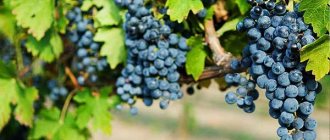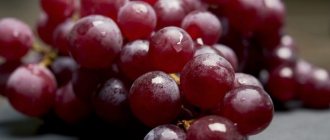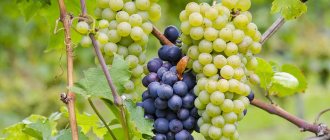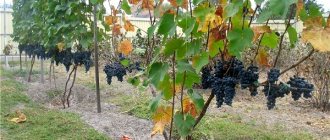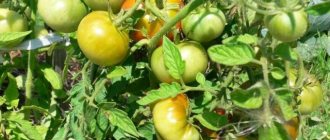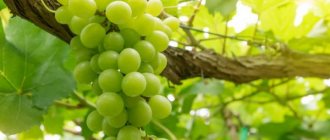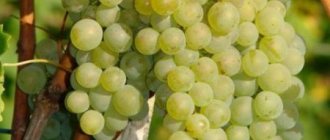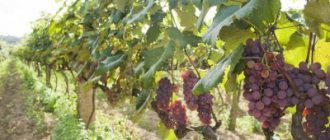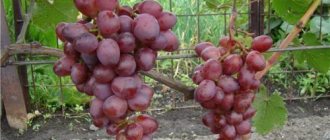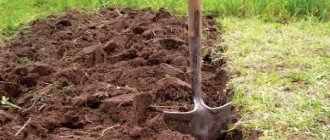The Korolek variety is very young. It belongs to the universal forms with super-early ripening. The harvest can be harvested in early August. Universal varieties also include Alexander, Druzhba and Krasa Balki.
Because of its rich Muscat taste, it is very popular among winemakers and is used in a blend of expensive dessert wines. Also popular in juices, desserts or simply as fresh fruit. As for blending, Alfa, Asya and Romeo are often used along with Korolkom.
According to reviews from gardeners, it tolerates storage and transportation well and rarely cracks. It is in great consumer demand due to its very beautiful clusters, sweetness and rich, revealing taste.
Grapes "Korolek": description of the variety and photo
Bushes with great growth vigor. The bunch is small in size, weighing up to 1 kg, cone-shaped, loose, sometimes winged. No peas were noticed.
The flowers are functionally female - even if official sources write about bisexuality, this is a mistake and the originator himself agrees with this.
The berry is large, about 12 g, oval, elongated, from reddish-green to deep red. The skin is dense, quite thick, edible. The pulp is juicy, dense, sweet, with a rich nutmeg aroma and an original aftertaste with strawberry and rose notes.
The berry contains 2-3 small seeds. The vine is brown, powerful. The leaves are bright green, medium-sized, heart-shaped, slightly cut. The shoots are brownish, with dark red nodules.
You can see more details about the Korolek grapes in the photo below:
Reviews about the variety
Tamara Nikolaevna, Oryol region
Of the early grape varieties, my choice fell on Coral. The berries begin to ripen in July. The beautiful color and oblong shape awaken the appetite. The taste is also excellent. Diseases have to be fought.
Most often, during the 5-year cultivation of this variety, fungal infections occurred, which manifested themselves in the form of brownish spots on the leaves and fruits. The significant disadvantages of Coral are: tendency to crack the skin, poor transportability.
Sergey, Krasnodar region
I purchased a summer cottage for going out with my family for barbecues on weekends. In the yard there were 4 apple trees, cherries and beautiful grapes. Later I learned that the variety is called Coral. The children immediately appreciated the taste of the berries. The large amount of sugar in the pulp could be judged by the wasps and bees that literally surrounded the ripe bunches. When eating grapes, you feel both sweetness and freshness.
The skin is almost invisible. But this has its downside - after an hour-long trip in a plastic bag, the berries were pretty crushed, and leaked juice collected inside. The plant endured the winter well, which was facilitated by wrapping it in geotextiles and digging the root zone with soil.
Watch the video about Coral Grapes:
Noticed a mistake? Select it and press Ctrl+Enter to let us know.
G.F.grapes selection V.V. Zagorulko
Ripening period (95-100 days).
Bunches weighing 600-900 g or more.
The berry is large, 10 g or more, nipple-shaped, dark red, harmonious taste.
Disease resistance 3-3.5 points.
Marketability is very high. the price of a grafted cutting is 300 rubles
- Author: Maria Sukhorukikh
Rate this article:
- 5
- 4
- 3
- 2
- 1
(0 votes, average: 0 out of 5)
Share with your friends!
Main characteristics
“Lydia” is a technical variety from which wine and juice are produced. These grapes are used to make jam, jam, jelly, marmalade, confectionery and baked goods. “Lydia” can also be consumed fresh. Technical American varieties also include Marquette, Alpha and Isabella.
Ripening period
"Lydia" is a late-ripening variety. The entire growing season from the beginning of sap flow to the moment of harvesting takes 150-160 days, that is, you should prepare for harvesting the brushes somewhere in the middle - end of October. The ripening of berries does not occur simultaneously: those clusters that are located on the sunny side ripen first.
Bush
The bushes are considered medium in volume, but at the same time very thick, consisting of 80% fruit-bearing shoots. The most suitable form for them is a fan: the bush has one or more main branches growing from the ground, from which the vines are distributed in different directions along the trellis. Visually it is similar to a lady's fan.
The leaves of the variety are large, covered with fluff and cut into 3 or 5 lobes. The flowers are bisexual, which means self-pollination.
Bunches and berries
The clusters are small in size and weigh only 100 g. Their shape is cylindrical-conical, with several branches, which is why the entire structure of the cluster is loose and loose.
The berries also do not amaze the imagination with their size and weight: only 4 g in weight and 15 mm in diameter. Their round shape is pink-violet. The skin is dense, covered with a coating of wax and is easily separated from the pulp. The latter, in turn, is juicy, has a slimy consistency, and contains 3 - 4 seeds. The sugar content in the pulp is quite high - 18 - 20%, while acidity levels range from 5.5 to 9.3%.
Taste
“Lidiya” has an unusual taste: it clearly has berry and strawberry notes. The unsurpassed aroma of berries is also striking, very persistent and rich.
Harvesting and application
The growing season of the variety is 95-105 days. The harvest begins in July. It is important not to overexpose the bunches on the vine so that the berries do not have time to fall off. The grapes have a completely marketable appearance, but due to the thin skin, it is recommended to place the crop in boxes, forming no more than three layers. During long-term transportation, multi-layer laying can damage the berries.
The purpose of the variety is table grapes, from which juices, purees, and wine are prepared. Part of the harvest is used as dessert. Gourmets rate the taste of the fruit as 4 points on a 5-point scale. When consumed fresh, the nutmeg note, sweetness and freshness are well felt.
Features of cultivation
Proper care of grapes is the key to plant health and a high-quality and abundant harvest.
Landing
The versatility of the variety can also be seen in its propagation: planting can be done both in spring and autumn. Spring planting usually occurs in April or May. During the warm summer, the young plant takes root well, grows stronger and calmly prepares for wintering. True, additional efforts will be required in order to provide regular watering to the seedling, especially during drought.
Autumn planting is usually carried out in October: before the real harsh winter trials, the small plant still has time to take root and acclimatize. The risk arises when the thermometer begins to creep down: without additional, well-thought-out shelter, the seedling may die. The optimal soil temperature for planting grapes is from +10ºС, air temperature – from +15ºС.
Place and soil
In order for “Lydia” to bear fruit successfully, several requirements must be met when planting:
- The location for the plot must be sunny and windless (preferably the southern part of the plot or vineyard).
- Soil fertility. The best option is chernozem or loam with an acidity pH of 6–7. It is important that the soil is loose and easily allows water and oxygen to pass through.
- Groundwater should not lie closer than 1.5 m from the surface.
- The optimal distance between future bushes should not be less than 1 m: “Lydia” is prone to thickening, which subsequently, if the established norm is not observed, will hinder the full development of the plant.
- The preparation of the planting pit should be done in advance so that the soil has time to settle a little. When planting in spring, the hole can be dug in the fall. Recommended depth – 90 cm.
- Filling the hole for the plant should be carried out strictly according to the algorithm: first drainage, then a mixture of organic matter, mineral fertilizers and fertile soil, on top - a layer of simple soil. It is important to ensure that the roots of the seedlings do not come into contact with fertilizers, otherwise they can be burned.
- After the young plant is buried to the middle, at least 10 liters of water should be poured under it, and after it is completely covered with soil - another 30 liters.
- A small peg is driven into the northern side of the young plant to support the new bush.
Watering and fertilizing
The “Lydia” variety is relatively drought-resistant: the plant will safely survive a short absence of rain and high temperatures. But if the weather stays like this for a long time, then you should definitely water the bush systematically, otherwise the berries will be small and sour.
The recommended watering rate is 12 - 15 liters per bush. To make the circumference of the tree trunk circles easier, grooves are dug to a depth of 20 cm.
The variety is usually watered as planned:
- In the spring, immediately after pruning.
- After all the branches are tied to the trellis.
- When the shoots grow to 25 cm in length.
- Before and after flowering.
- During ripening.
- After the harvest.
To retain moisture in the roots, it is advisable to mulch the soil around the plant trunk using peat, humus, sawdust, and grass. Such raw materials will not only become an obstacle to the evaporation of moisture, but will also serve as a good fertilizer.
For abundant fruiting, Lydia grapes need fertilizing. Experienced winegrowers recommend applying fertilizers every season according to the following scheme:
- In March and 2 weeks before flowering: per bucket of water: 10 g of ammonium nitrate, 20 g of double superphosphate, 5 g of potassium salt.
- Before ripening: 20 g of double superphosphate, 5 g of potassium salt per bucket of water.
- After harvest: 15 g of potassium chloride per 1 m2.
Description of the cherry variety Lyubimitsa Astakhova, planting and care diagram
Trimming
Professional winegrowers recommend pruning “Lydia” vines to 6–8 buds. It is also necessary to remove unnecessary stepsons and shorten shoots in the second half of June.
The bush should be formed from the second year of life of the grapes, making 3 prunings per season:
- Spring pruning involves removing dried and damaged branches. It is performed even before the start of sap flow, at an air temperature of +5ºС.
- In summer, bushes are thinned to ensure ventilation.
- In the fall (October - November) the most important pruning is performed: in the first year - by 2 - 4 eyes, in the second - by 6 - 8, and in the third - by 15. The recommended load of an adult bush is 35 - 50 eyes.
Diseases and pests
The “Lydia” variety is resistant to oidium and mildew, but the gardener often faces the problem of chlorosis, anthracnose and gray rot on the plant. Grapes are also susceptible to attacks from phylloxera, which strikingly distinguishes them from their “progenitor,” as well as spider mites and leaf rollers.
To protect the variety from infection, it is necessary to carry out timely preventive irrigation of the bushes with fungicides and insecticides, and also to ensure that debris of dry grass and fallen leaves do not accumulate under the plant. After harvesting, the soil under the bush needs to be dug up, and one should not forget about timely application of fertilizers.
Lydia berries attract birds and wasps. They also need to be fought, otherwise the winegrower may lose a significant share of the harvest or harvest fairly spoiled fruits. You can protect the bunches with special mesh caps or fence the entire grape planting with stretched nets. Optical, ultrasonic or simply sound repellers will help in the fight against birds, which can be purchased in specialized stores or built independently (a hanging bell, foil strips). Placed sweet baits and traps will help against wasps, and chemical treatment as a last resort.
Wintering
“Lydia” is able to safely survive a temperature drop to -26ºС. If such a temperature jump is single, then in warm winter conditions the plant does not need shelter. However, in regions with a temperate climate, the insulation of grape bushes should not be neglected.
The covering process is simple: in November, the branches are removed from the trellises, laid on the ground, tied, after which they are sprinkled with a 10-15 cm layer of earth. A kind of protection can be strengthened with boards supporting the sides of the structure.
Storage
Ripe clusters of Lydia grapes should not hang on the bushes for a long time: overripe berries will begin to fall off. Timely harvested crops are stored in boxes up to 15 kg with ventilation holes.
Recommended storage conditions are 0 -3ºС and 90 - 95% humidity. The variety will last for about 3 months in such conditions without problems, but in the refrigerator (+8ºС) - about 2 months.
The thick skin of the berries is the key to successful transportation of the bunches, so grapes can be transported over long distances without fear.
Regions
The variety feels great in the southern regions of the Russian Federation and countries: Moldova, Ukraine. It has successfully acclimatized in regions with temperate climates and in the northern regions.
The only condition is that the plant must be insulated for the winter.
Advantages and disadvantages
Pros:
- The need for a minimum number of care activities.
- Absolute resistance to mildew and powdery mildew, as well as low temperatures.
- Excellent transportation, storage for several months.
- The presence of bisexual flowers on the bush.
- High sugar content.
Minuses:
- Vulnerability to phylloxera.
- Regular taste.
- The need for constant control over the number of shoots and stepchildren.
- Shedding of overripe berries from the stalk.
- Susceptibility to lime chlorosis due to a lack of iron in the soil.
Plant care
Like all shrub plants, the kinglet grape needs timely care, for which it will reward with its fertility and incomparable tasty berries, but this does not mean that it is excessively demanding of care.
The variety is frost-resistant, is not afraid and can withstand -25 degrees, but requires mandatory covering in winter, is capricious to sudden changes in weather conditions, and rainstorms and spring frosts adversely affect its condition. It is problematic to graft a plant, which must be carried out to ensure stability and prevent the appearance of harmful root parasites, the most common of which is root phylloxera, which can destroy young bushes.
Grapes are highly resistant to gray rot and fungal diseases such as mildew and oidium; they are also not afraid of wasps, to which they are almost invulnerable.
Caring for the bush should include the removal of dry branches, as well as pruning stepsons and shoots with a standard of 45 eyes for the entire grape bush.
Characteristics
Outwardly, he resembles his “parent” - Tason, but fortunately did not inherit increased pain from him. The grapes are resistant to frost - down to -25 degrees Celsius, and are practically invulnerable to wasps .
Very resistant to gray rot, powdery mildew and downy mildew, somewhat less resistant to phylloxera. Sugar content 19-21%.
Problematic compatibility with rootstocks. The yield is moderate, since the variety is capricious to weather conditions, afraid of showers and spring frosts.
Ripens almost the entire length of the growth. It is not yet possible to say for sure about the remaining qualities - the variety is being tested in Belarus.
Requires mandatory shelter for the winter months. Stepchildren and excess shoots need to be trimmed, leaving up to 45 eyes per bush.
Comparison with analogues
From America in 1948, the technical variety of black grapes “alpha” was also brought to the territory of the USSR.
Just like “Lydia”, “American” ripens only for 150 days, has a bisexual flower, is used in landscaping walls and balconies, has a slimy flesh and a cylindrical-conical shape of the brush.
In favor of “Lydia” is the fact that “alpha” is not resistant to mildew, chlorosis and oidium. But this variety is ahead of “Lydia” in terms of frost resistance: it can easily survive frosts of -35ºС. And the yield of “alpha” is higher – up to 150 centners per hectare.
The versatile pink grape variety “Korolek” is also used for wine production. Its advantage is evidenced by its early ripening period, large clusters (up to 1 kg) and berries (up to 12 g), interesting taste with nutmeg notes, and invulnerability to wasps.
It is related to “Lydia” in terms of sugar content (19 – 21%) and frost resistance (up to -26ºС). But the “kinglet” is not in favor of problematic compatibility with rootstocks, the presence of only female flowers on the bushes and vulnerability to a significant list of diseases and pests.
Description of the nuances of cultivation
The Korolek-shaped grapes are very similar in appearance to one of their parents, Tason, but the description of this variety makes it possible to identify their significant differences in terms of key characteristics, in particular, resistance to disease.
The Korolek variety is characterized by increased frost resistance; its bushes can withstand cold temperatures down to -25C, but they still need to be covered for the winter.
Resistance to diseases (gray rot, powdery mildew and downy mildew) is 2 points, this figure is slightly lower for phylloxera. Resistance to pests is good: wasps almost do not damage the crop.
The disadvantage of the variety is its dependence on changeable weather conditions: the grapes do not tolerate rainy climates and spring frosts and under such factors can produce little yield. Bushes need regular thinning of shoots and excess shoots. Normally, it is recommended to load the eyes up to a maximum of 45 per plant.
Compatibility with rootstocks can be described as problematic. The ripening of the vine is good, almost throughout the entire length of the seasonal growth. There is no data yet regarding other qualities, since testing of the Korolek variety is still ongoing.
History of selection
Korolek is a new hybrid subspecies of breeder E.G. Pavlovsky. “Parents” - Talisman and Tason (Kherson region). The task was to develop a nutmeg that would not be as vulnerable as many others and would be accessible even to farmers in those regions where winters are harsh.
Judging by the preliminary test results and feedback from farmers, this variety is still afraid of cold weather; it was not possible to achieve the same result of frost resistance as with the varieties Super Extra, Krasa Severa, and Alexa because its distribution area almost does not rise to the north of Ukraine and the Krasnodar Territory.
Description of variety development
The hybrid grape form Korolek is the fruit of amateur selection. It was bred by E. G. Pavlovsky in the Kherson region, Ukraine, based on the Talisman and Tason varieties. The creator of the variety set himself the goal of obtaining a nutmeg that is highly frost-resistant, the cultivation of which would be possible in regions with a harsh climate. However, the first data obtained during its tests and reviews from winegrowers indicate that the variety still does not have absolute invulnerability to cold weather, therefore the geographical area of its distribution is mainly the territory of Ukraine and the Krasnodar Territory; in more northern latitudes its cultivation is difficult.
Treatment of grapes
Ridding a variety from pests and diseases includes:
- There are no chemicals to completely destroy bacterial cancer; effective bactericides can kill only superficial bacteria, so to prevent the bush from being exposed to a dangerous disease, it is necessary to carry out prevention. It consists of timely, careful thinning of the bush, avoiding damage to its integrity, and fertilizing the grapes. If bacterial cancer has settled on the plant, then the entire bush is dug up and destroyed;
- insecticides are used against leaf phylloxera; if its root form is observed, then the bushes are mainly uprooted, but the introduction of toxic substances into the soil (fumigation) is also used;
- A dense fencing net that can prevent birds from accessing the plant and its fruits will help keep birds away.
Cabbage: rules for planting before winter and recipes for preparations
Having such exceptional grapes on his plot, the gardener will be proud of his find, because the wren is suitable for use in creating unsurpassed Muscat wine, as well as preparing delicious jam and jam, and eating fresh berries.
What's special about Korolek grapes
Another result of the successful but complex private selection of E.G. Pavlovsky – hybrid variety Korolek. Many people have heard about it, as it has first-class taste properties among nutmeg varieties. Korolek has proven itself as a raw material for producing expensive wine and high-quality liqueurs.
Bunches of Korolek grapes
The variety has been poorly studied due to its relative youth. But the available information will be very useful for everyone who likes to “try” new varieties on their plot to obtain a harvest of high taste properties. Moreover, the hybrid turned out to be not ideal and has a number of problem areas.
Diseases and pests
The wren is not afraid of fungi , and this is its undoubted advantage. Even wasps are not afraid of him , but a bird-resistant variety has not yet been developed. Therefore, a mesh fence will protect you from birds, which would be a barrier for birds, but not a trap.
Bacterial cancer .
Rarely, but still this attack can affect the Kinglet. Therefore, the bush must be thinned out, fertilized, and the seedlings must be handled more carefully - any wound or scratch on the bark can become the “foundation” for grape oncology.
They have not yet learned how to treat diseased bushes - just uproot them. To protect plants from diseases such as anthracnose, chlorosis, oidium and mildew, preventive measures must be taken in a timely manner. You can read about them in detail in the relevant materials.
Another enemy may also make itself known - phylloxera . The method of combating it is quite extreme, since it threatens the grapes themselves, but it is effective - spraying with a carbon disulfide composition.
Moreover, if you make the dose of carbon disulfide small, there will be no benefit from such treatment.
Farmers are advised not to lower it below 80 cc. per square meter.
The grapes cannot boast of either very large clusters or high yields, and frost resistance is still in question. Proven high-yielding varieties Podarok Magaracha, Anniversary of the Kherson Summer Resident and Pamyati Dombkovskaya have their own advantages and disadvantages.
But he is not afraid of wasps, and protection from phylloxera and care are a very small price to pay for such tasty and aromatic grapes, the muscat bouquet of which is rarely found in anyone.
Features of planting and care
Sensitivity to cold and frost requires that the bushes be covered for the winter.
To maintain a stable load, it is necessary to systematically prune shoots and stepsons.
Description of methods to counter birds:
- the use of special mesh bags on the bunches;
- creating a special mesh flooring over the bushes (it is important to use materials that transmit light and moisture well);
- the “good old” attitude was scary;
- use of modern models of sound repellers.
Bacterial cancer is especially dangerous. This incurable lesion leads to a decrease in yield, a deterioration in the size and taste characteristics of the berries, and a general decrease in the plant’s “immunity” to the effects of natural factors and other diseases. The plant weakens very much, and cases of complete death of the bush are not uncommon. Can be transmitted to neighboring plants. It appears in the form of a tumor-like growth on the vine or trunk, which breaks through the bark and grows intensively. The growth is yellow-white, brown or black. Size varies from 1 to 40 cm.
At the moment, there are no effective remedies and treatments for bacterial cancer, for this reason it is recommended to pay special attention to preventive measures.
Description of preventive measures against bacterial cancer:
- systematic thinning of bushes, removal of dried, severely damaged branches and vines, cleaning of dead foliage;
- timely watering and fertilizing the soil;
- competent selection and careful handling of seedlings, cuttings and shoots;
- avoiding any mechanical damage to the plant bark;
- use of clean, disinfected instruments during maintenance, treatment and protection of cut areas and damage;
- treatment with special antibacterial drugs.
Timely watering and fertilizing the soil
If bushes affected by bacterial cancer are identified, you must immediately uproot the diseased bush, dig up and clean the soil, and leave it to “rest” for 3-5 seasons. If the disease is detected in a timely manner, you can try to remove the affected area (the vine is cut to the level of a healthy area), burn the growth, disinfect the cut with a 5% solution of copper sulfate and lubricate it with garden varnish. If the trunk, roots are damaged, or if the lesion spreads after local removal of the area with the growth, the entire bush is removed. It is very important to try to remove all the roots from the soil (you can replace the soil in the area where the diseased bush grows).
An effective means of combating phylloxera is spraying the affected bushes with special carbon disulfide preparations. Particular attention should be paid to the dosage of the drug. Since phylloxera is quite resistant, insufficient concentration will not get rid of the “sore”, and excessive concentration will also not be beneficial, since these drugs are harmful not only to phylloxera, but also to the grapes themselves. Experienced winegrowers recommend using 80 cc. drug per 1 sq.m. plant area.
Appearance
The bushes have great growth vigor.
The clusters , as a rule, are small, cone-shaped and slightly loose, and can reach a weight of up to 1 kilogram. No peas are observed.
Flowers are feminine in their functionality, and although official sources often write about bisexuality, this is not true, which the breeder himself agrees with.
The berries are large, approximately 12 grams, slightly elongated and can range from pinkish-green to bright red. The skin is thick, dense, but quite edible. The pulp is dense, very sweet and juicy, has a rich musky flavor and aroma with a subtle strawberry aftertaste. The berries always contain 2-3 seeds, and the vine is powerful and brown in color.
The leaves of the Korolek grape are bright green, medium-sized and heart-shaped. The shoots are slightly brownish, with burgundy-red nodules.
Selection of the Korolek grape variety
Korolek is the newest hybrid created by the famous breeder Pavlovsky. The creation of the Korolek variety is based on Tason and Talisman.
When creating this variety, the task was to develop a variety that would not be very vulnerable, like most other muscats, and would be accessible to farmers even in those regions where winters are quite severe.
According to preliminary experiments, the variety is still afraid of cold weather, so it was not grown in areas north of the Krasnodar Territory and Ukraine.
Characteristics of the Korolek variety
In terms of external characteristics, this hybrid resembles Tason, from which, fortunately, the excessive soreness of the “parent” was not inherited.
The grapes are frost-resistant - can withstand down to -25°C, and are also practically invulnerable to wasps.
The variety is also resistant to gray rot, powdery mildew and phylloxera. Sugar content is approximately 18-22%.
The yield of the variety is average, since the variety is quite capricious to all kinds of conditions (including weather), and is also very afraid of April frosts and summer showers.
All excess shoots need to be gotten rid of almost immediately; normally there should be about 45 eyes per bush.
The grapes ripen almost their entire length and require good shelter for the winter.
Characteristics of the variety
Korolek grapes are a young universal grape variety. A new hybrid form obtained as a result of the breeding activities of the famous winegrower E.G. Pavlovsky. The homeland of the variety is the Kherson region. The hybrid is obtained from two “parental” forms – Tason and Talisman. The goal of breeding the variety was to obtain a grape plant with a muscat taste that would be resistant to painful lesions and harsh winter conditions. In most respects, Pavlovsky coped with the task, although the degree of cold resistance was insufficient, which limited the range of distribution of the variety to northern Ukraine and the Krasnodar region of Russia.
In terms of its visual characteristics, the hybrid is close to the “parent” Tason, but in terms of “internal” characteristics it is free from the latter’s soreness.
- The extremely early ripening period is 95-110 days. The fruits ripen and are ready for harvest in early August.
- The bushes are characterized by great growth vigor. The vine is developed, brown in color, ripens to its full length. The leaves are medium in size, heart-shaped with small cuts, and under normal conditions are bright green. The shoots are brown with dark red nodules. The load rate is up to 45 buds per bush.
- The optimal method of planting is with one-year-old seedlings . Very sensitive in matters of compatibility with other varieties when used as a scion.
- It is especially worth mentioning the issue of flower gender. A number of sources note that the variety belongs to bisexual plants. But this is not true; they write this way to improve the characteristics of the plant. The wren has flowers with pronounced female functionality.
- Productivity is moderate. The volume and quality of the harvest is greatly influenced by the climate; the Kinglet is “afraid” of showers and early spring frosts.
- High degree of resistance to frost - up to -25 degrees.
- Good resistance to damp rot, to true and downy mildew. Phylloxera infection can pose a great danger. Cases of destructive bacterial cancer of grapes have been reported.
- The characteristics of the skin of the fruit, the structure of the bush and branches make the variety resistant to the negative influence of wasps. Birds can pose a serious threat.
Ripe bunch of Korolek grapes
Fruit
Description of the characteristic features of berries and bunches:
- The berry is large in size. Shape – oval or oval-elongated. Weight – from 9 to 12 g.
- Color varies from reddish green to deep red and pink, depending on the degree of ripening, sufficient sunlight and heat during ripening.
- It stands out for the nobility of its taste. Pronounced rich nutmeg taste. Professionals and connoisseurs note the complex, revealing taste of the variety’s fruits. The complexity of the taste lies in the harmonious combination of sweetness and nutmeg aroma, followed by an aftertaste in the form of strawberry and rose notes. Many experienced winegrowers note the caramel muscat taste, which is more pleasant than that of the “parent” Tason.
- High sugar content, which has a positive effect on its use in winemaking.
- In some cases, berries are susceptible to cracking. No peeling occurs.
- The pulp is juicy and dense. There are 2-3 small seeds.
- The skin is dense, quite thick, but tender, for this reason it does not affect the sensations when eating or the taste.
- The clusters are small in size, weight - from 0.5 to 1 kg. The shape of the bunch is cone-shaped and sometimes winged. Looseness is characteristic. A minor drawback is the uneven ripening of the berries on the bunch.
- It is recommended to harvest ripe crops from the bushes in a timely manner, since “overweight” can affect the quality of the berries.
A bunch of Korolek grapes can reach a weight of 0.5-1 kg.
Grapes, due to their properties, have very wide applications. Grown for fresh consumption. Korolek berries serve as an excellent raw material for the preparation of high-quality professional and home Muscat wine. Used in a blend of expensive dessert wines. Actively used for jam, making juices, sweet fruit desserts, etc.
It has good transportability and storage qualities, which makes it in demand in the trade sector. Korolek is popular among buyers for the following indicators:
- beautiful bunches and berries;
- sweetness and unique taste.
Winegrowers note the good adaptability of Korolka bushes for solving decorative problems - decorating gazebos, fences and other buildings on the site with flexible, strong and beautiful vines.
What type does it belong to?
The Korolek variety is very young. It belongs to the universal forms with super-early ripening. The harvest can be harvested in early August. Universal varieties also include Alexander, Druzhba and Krasa Balki.
Because of its rich Muscat taste, it is very popular among winemakers and is used in a blend of expensive dessert wines. Also popular in juices, desserts or simply as fresh fruit. As for blending, Alfa, Asya and Romeo are often used along with Korolkom.
According to reviews from gardeners, it tolerates storage and transportation well and rarely cracks. It is in great consumer demand due to its very beautiful clusters, sweetness and rich, revealing taste.
conclusions
- “Lydia” is a technical variety of pink grapes with high levels of sugar content, yield and frost resistance.
- The variety is very unpretentious in care, which has ensured it the real “love” of many amateur winegrowers.
- The berries have a good taste and strong aroma, which allows them to be widely used in cooking and confectionery.
- The production of wine from Lydia is a controversial issue. For many centuries, strong drinks were successfully produced from this variety at home without any sad consequences. But scientific facts tell a different story. In any case, drinking alcohol in large quantities is fraught with human health.
You may be interested in learning about other technical varieties
